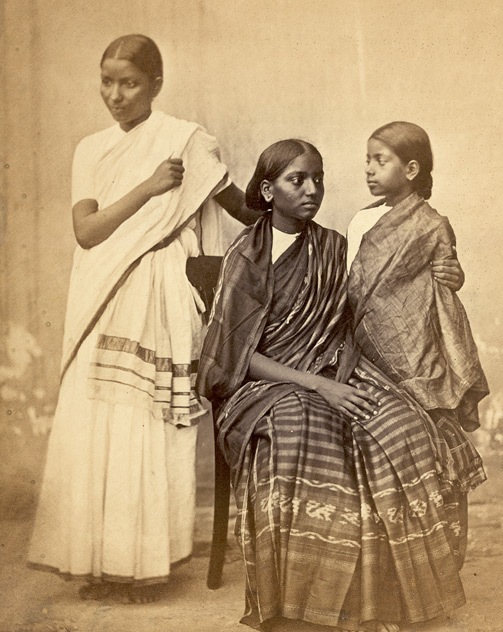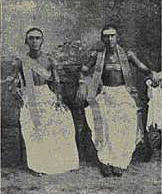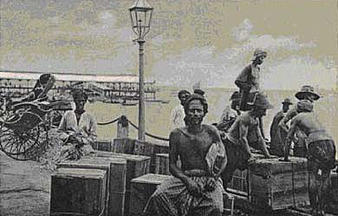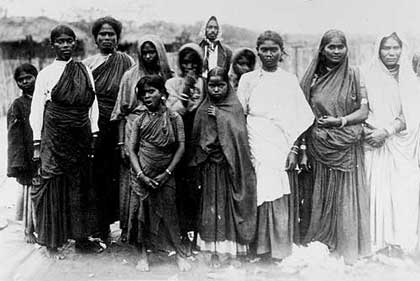மலாயா காலனித்துவத்தில் இந்தியர்கள்
It was only in the early 20th century that saw a dramatic influx of female immigrants, both Chinese and Indians to Malaya, many, to join their husbands. The Aliens Ordinance Act which restricted further recruitment of male workers sparked a wave of female workers. The Indian female migrants worked in plantations as rubber tappers and weeders while the Chinese were mostly found in tin mines as dulang washers. Those English speaking ones worked as amahs looking after the children of European families.
By the 1940s, they formed about 50% of the workforce toiling in the estates and tin mines, and other ancillary occupations.

 On
the left: a female Indian rubber tapper in an estate. On the right,
Indian women workers sorting rubber seeds collected for planting
On
the left: a female Indian rubber tapper in an estate. On the right,
Indian women workers sorting rubber seeds collected for planting






 Chinese
women and children arriving to work in the tin mines and rubber
estates. Inset: Chinese dulang washers, the most famous of whom were
the Samsui women
Chinese
women and children arriving to work in the tin mines and rubber
estates. Inset: Chinese dulang washers, the most famous of whom were
the Samsui women
Most gravitated to the tin mines as dulang washers, panning for tin ore, though a substantial number also worked in rubber estates and agricultural farms. The women from Samsui, a district of Guandong, were hardy women well-known for doing heavy manual work.
 Left:
those who lived in towns worked as domestic helpers. Right: A
fortunate few worked with European families as child minders.
Left:
those who lived in towns worked as domestic helpers. Right: A
fortunate few worked with European families as child minders.
Life was hard for the predominantly immigrant male workforce in the 18th and early 19th century. Prostitution was condoned although the manner of acquisition by buying, kidnapping and trickery was inhumane. They worked and lived in sordid and abject condition. Yap ah Loy, the Kapitan China of Kuala Lumpur is reported to own 300 prostitutes in his brothels in 1883.
கடந்த கால பிரிட்டிஷ் காலனித்துவத்தில் இந்தியர்களும் சீனர்களும் அனுபவித்த வேதனைகளைத் தெளிவாகக் காட்டும் அரிய புகைப்படங்கள் - ஓவியங்கள்.
It was only in the early 20th century that saw a dramatic influx of female immigrants, both Chinese and Indians to Malaya, many, to join their husbands. The Aliens Ordinance Act which restricted further recruitment of male workers sparked a wave of female workers. The Indian female migrants worked in plantations as rubber tappers and weeders while the Chinese were mostly found in tin mines as dulang washers. Those English speaking ones worked as amahs looking after the children of European families.
By the 1940s, they formed about 50% of the workforce toiling in the estates and tin mines, and other ancillary occupations.

 On
the left: a female Indian rubber tapper in an estate. On the right,
Indian women workers sorting rubber seeds collected for planting
On
the left: a female Indian rubber tapper in an estate. On the right,
Indian women workers sorting rubber seeds collected for planting
கங்காணியின் மனைவிகளும் மகளும்

1900களில் சிம்மோர் வட்டார ரப்பர்
தோட்டங்களில் வேலை செய்த தமிழர்கள்

The Anglo-Tamil School in Singapore, which was started
as an outreach to the Tamils in September 1885.


1886 - 1920 களில் மலாயாவுக்கு வந்த தமிழர்கள்

தென் ஆப்பிரிக்காவிற்குச் சென்ற தமிழர்கள்
 Chinese
women and children arriving to work in the tin mines and rubber
estates. Inset: Chinese dulang washers, the most famous of whom were
the Samsui women
Chinese
women and children arriving to work in the tin mines and rubber
estates. Inset: Chinese dulang washers, the most famous of whom were
the Samsui womenMost gravitated to the tin mines as dulang washers, panning for tin ore, though a substantial number also worked in rubber estates and agricultural farms. The women from Samsui, a district of Guandong, were hardy women well-known for doing heavy manual work.
 Left:
those who lived in towns worked as domestic helpers. Right: A
fortunate few worked with European families as child minders.
Left:
those who lived in towns worked as domestic helpers. Right: A
fortunate few worked with European families as child minders.Life was hard for the predominantly immigrant male workforce in the 18th and early 19th century. Prostitution was condoned although the manner of acquisition by buying, kidnapping and trickery was inhumane. They worked and lived in sordid and abject condition. Yap ah Loy, the Kapitan China of Kuala Lumpur is reported to own 300 prostitutes in his brothels in 1883.




